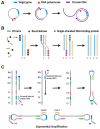Paper-Based Biosensors for the Detection of Nucleic Acids from Pathogens
- PMID: 36551061
- PMCID: PMC9776365
- DOI: 10.3390/bios12121094
Paper-Based Biosensors for the Detection of Nucleic Acids from Pathogens
Abstract
Paper-based biosensors are microfluidic analytical devices used for the detection of biochemical substances. The unique properties of paper-based biosensors, including low cost, portability, disposability, and ease of use, make them an excellent tool for point-of-care testing. Among all analyte detection methods, nucleic acid-based pathogen detection offers versatility due to the ease of nucleic acid synthesis. In a point-of-care testing context, the combination of nucleic acid detection and a paper-based platform allows for accurate detection. This review offers an overview of contemporary paper-based biosensors for detecting nucleic acids from pathogens. The methods and limitations of implementing an integrated portable paper-based platform are discussed. The review concludes with potential directions for future research in the development of paper-based biosensors.
Keywords: paper-based biosensors; pathogens; point-of-care testing.
Conflict of interest statement
M.S.V. has interests in Krishi, Inc., which is a startup company developing paper-based molecular assays. Krishi, Inc. did not fund this work.
Figures






Similar articles
-
Prospects of Microfluidic Technology in Nucleic Acid Detection Approaches.Biosensors (Basel). 2023 May 27;13(6):584. doi: 10.3390/bios13060584. Biosensors (Basel). 2023. PMID: 37366949 Free PMC article. Review.
-
Microfluidic-integrated DNA nanobiosensors.Biosens Bioelectron. 2016 Nov 15;85:247-260. doi: 10.1016/j.bios.2016.05.009. Epub 2016 May 4. Biosens Bioelectron. 2016. PMID: 27179566 Review.
-
Label-free electrochemical microfluidic biosensors: futuristic point-of-care analytical devices for monitoring diseases.Mikrochim Acta. 2022 Jun 10;189(7):252. doi: 10.1007/s00604-022-05316-3. Mikrochim Acta. 2022. PMID: 35687204 Review.
-
Review of Integrated Optical Biosensors for Point-Of-Care Applications.Biosensors (Basel). 2020 Dec 18;10(12):209. doi: 10.3390/bios10120209. Biosensors (Basel). 2020. PMID: 33353033 Free PMC article. Review.
-
Advances in functional nucleic acid based paper sensors.J Mater Chem B. 2020 Apr 29;8(16):3213-3230. doi: 10.1039/c9tb02584g. J Mater Chem B. 2020. PMID: 31942914 Review.
Cited by
-
Polydopamine-encapsulated carbon dots to boost analytical performance for microplastics detection in fluorescence mode.Mikrochim Acta. 2025 Jan 17;192(2):91. doi: 10.1007/s00604-024-06937-6. Mikrochim Acta. 2025. PMID: 39820678
-
A paper-based loop-mediated isothermal amplification assay for highly pathogenic avian influenza.Sci Rep. 2025 Apr 9;15(1):12110. doi: 10.1038/s41598-025-95452-6. Sci Rep. 2025. PMID: 40204842 Free PMC article.
-
Interactions between Humans and Dogs during the COVID-19 Pandemic: Recent Updates and Future Perspectives.Animals (Basel). 2023 Feb 2;13(3):524. doi: 10.3390/ani13030524. Animals (Basel). 2023. PMID: 36766413 Free PMC article. Review.
-
Propidium Monoazide is Unreliable for Quantitative Live-Dead Molecular Assays.Anal Chem. 2025 Feb 11;97(5):2914-2921. doi: 10.1021/acs.analchem.4c05593. Epub 2025 Jan 27. Anal Chem. 2025. PMID: 39870608 Free PMC article.
-
Advancing Microfluidic Immunity Testing Systems: New Trends for Microbial Pathogen Detection.Molecules. 2024 Jul 15;29(14):3322. doi: 10.3390/molecules29143322. Molecules. 2024. PMID: 39064900 Free PMC article. Review.
References
-
- Abayasekara L.M., Perera J., Chandrasekharan V., Gnanam V.S., Udunuwara N.A., Liyanage D.S., Bulathsinhala N.E., Adikary S., Aluthmuhandiram J.V.S., Thanaseelan C.S., et al. Detection of Bacterial Pathogens from Clinical Specimens Using Conventional Microbial Culture and 16S Metagenomics: A Comparative Study. BMC Infect. Dis. 2017;17:631. doi: 10.1186/s12879-017-2727-8. - DOI - PMC - PubMed
-
- Kok J., Blyth C.C., Foo H., Patterson J., Taylor J., McPhie K., Ratnamohan V.M., Iredell J.R., Dwyer D.E. Comparison of a Rapid Antigen Test with Nucleic Acid Testing during Cocirculation of Pandemic Influenza A/H1N1 2009 and Seasonal Influenza A/H3N2. J. Clin. Microbiol. 2010;48:290–291. doi: 10.1128/JCM.01465-09. - DOI - PMC - PubMed
Publication types
MeSH terms
Substances
Grants and funding
LinkOut - more resources
Full Text Sources

